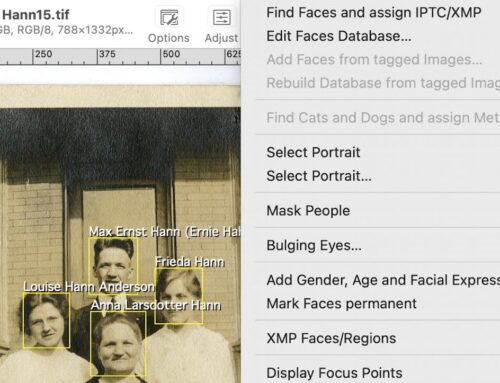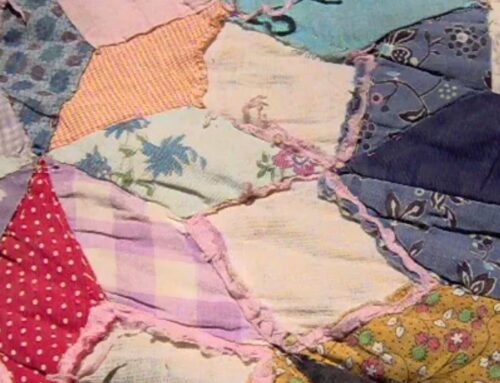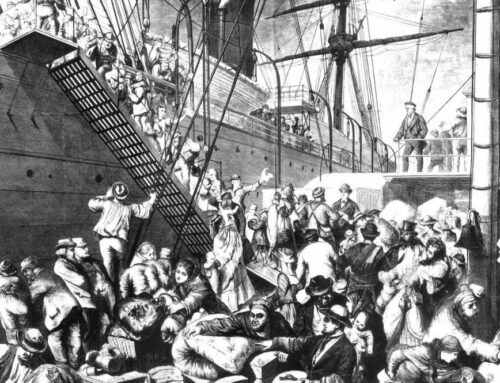Are you caring for
scrapbook family photographs?
Do your scrapbook family photographs
look like the one above?
Here are some solutions from an archivist-genealogist.
During #AskAnArchivist Day, Missy asked:
I’ve been given large portions of my grandmother’s photographic/scrapbook collection and also her eldest brother’s. Some of the photos from his collection in particular seem to have been in one of those black paper scrapbooks at some point, then ripped out of them. Do I need to worry about trying to remove the remnant bits of glue and black (presumably non-acid free) paper off the backs? and if so, how do I get it off safely? For now, I have them in archival bins, but to display them – I’m guessing it would be best to make copies and display those?? Thanks!
First, congratulations on having actual vintage photographs of your family, Missy. All of your instincts are correct. So let’s take it step-by-step:
1. Do not try to remove the adhesive and acidic black bits of the scrapbook paper from the photos.
Photographs from scrapbooks are fragile because the glue and the paper used in scrapbooks were cheap and therefore highly acidic. Add in the chemical processes built in to photographs and you have a recipe for decay. Reversing this process is expensive. So the best alternative is scanning.
2. Scan these photos at a MINIMUM of 300 PPI (pixels per inch)* or more.
The highest available PPI is best because:
- Resolution of images can be decreased but not increased.
- Scanning once at high resolution means you won’t have to redo your scans later.
*PPI is the measurement for scanning images; DPI (dots per inch) is the measurement for ink dots printing images. These days the terms are used interchangeably.
 For more information on scanning, labeling, and making copies of digital images to share, my e-book, Cataloging Digital Family Photographs & Records, contains step-by-step information.
For more information on scanning, labeling, and making copies of digital images to share, my e-book, Cataloging Digital Family Photographs & Records, contains step-by-step information.3. House the original photographs in quality polyester (preferably Mylar) sleeves.
To be completely honest, I get nervous when genealogists tell me they buy acid-free supplies at Walmart, Office Depot, or other retail outlets that aren’t in the preservation business. Now defunct Precious Memories sold “archival” supplies via house parties; Gaylord and other library suppliers also tout their archival supplies. But professional archivists order their archival housing from Hollinger-Metal Edge, the leader in this field since 1945. If they say it’s acid-free, you can count on it. Products I really like include:
- File Folders
- Flip-top Document Storage Boxes
- Textile Storage (also great for flat oversized documents)
- 3-mil. Archival Polyester Sleeves
If you’ve heard my presentation on organization, you know that this is where you should be spending your storage dollar, rather than on elaborate binders, color-coded systems, and sheet protectors from discounters and office supply stores. Please store your original and vintage materials appropriately in trusted archival supplies like the ones from Hollinger. Please note: I have no financial interest in Hollinger; I recommend them without reimbursement or affiliate fees.
Use code XXV for 20 percent off at checkout through 31 May 2017.
4. Store the originals in a stable environment.
DO NOT store original family papers and photographs in:
- Attics or basements or storage spaces where the temperature varies widely throughout the year
- Direct sunlight or incandescent light
- Lamination causes irreversible damage
- Check the backs of old framed family photographs. Acidic wood and paper backing in old frames can damage your photographs.
- Handle photographs at the edges with clean, dry hands. If you intend to work with your family papers for more than a few minutes, wear gloves.





Leave a Reply